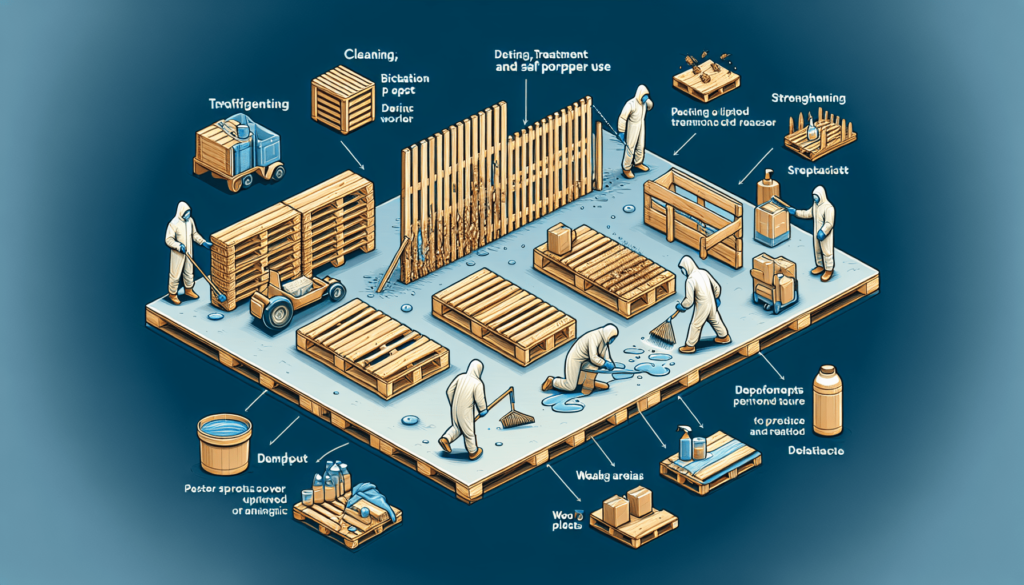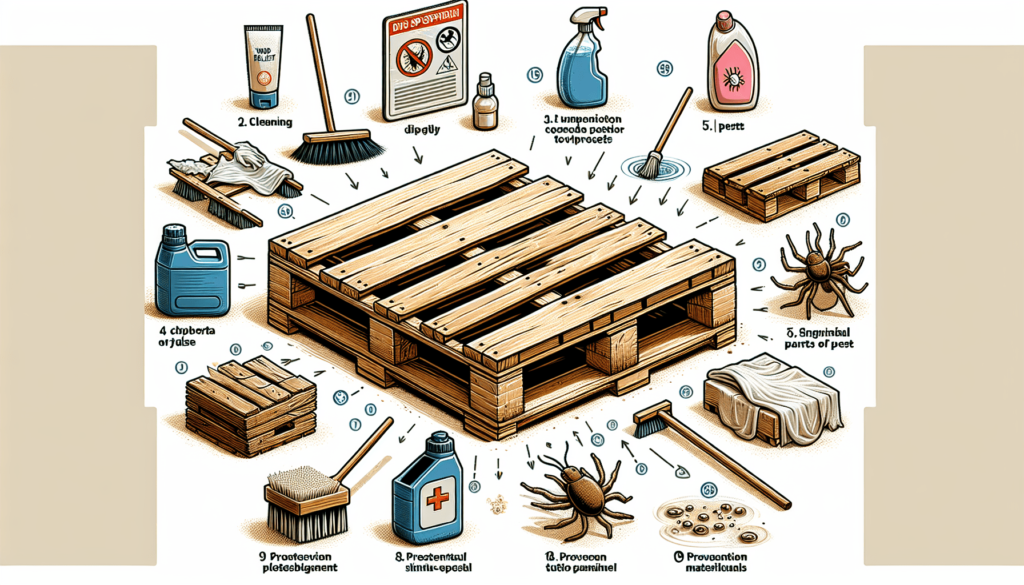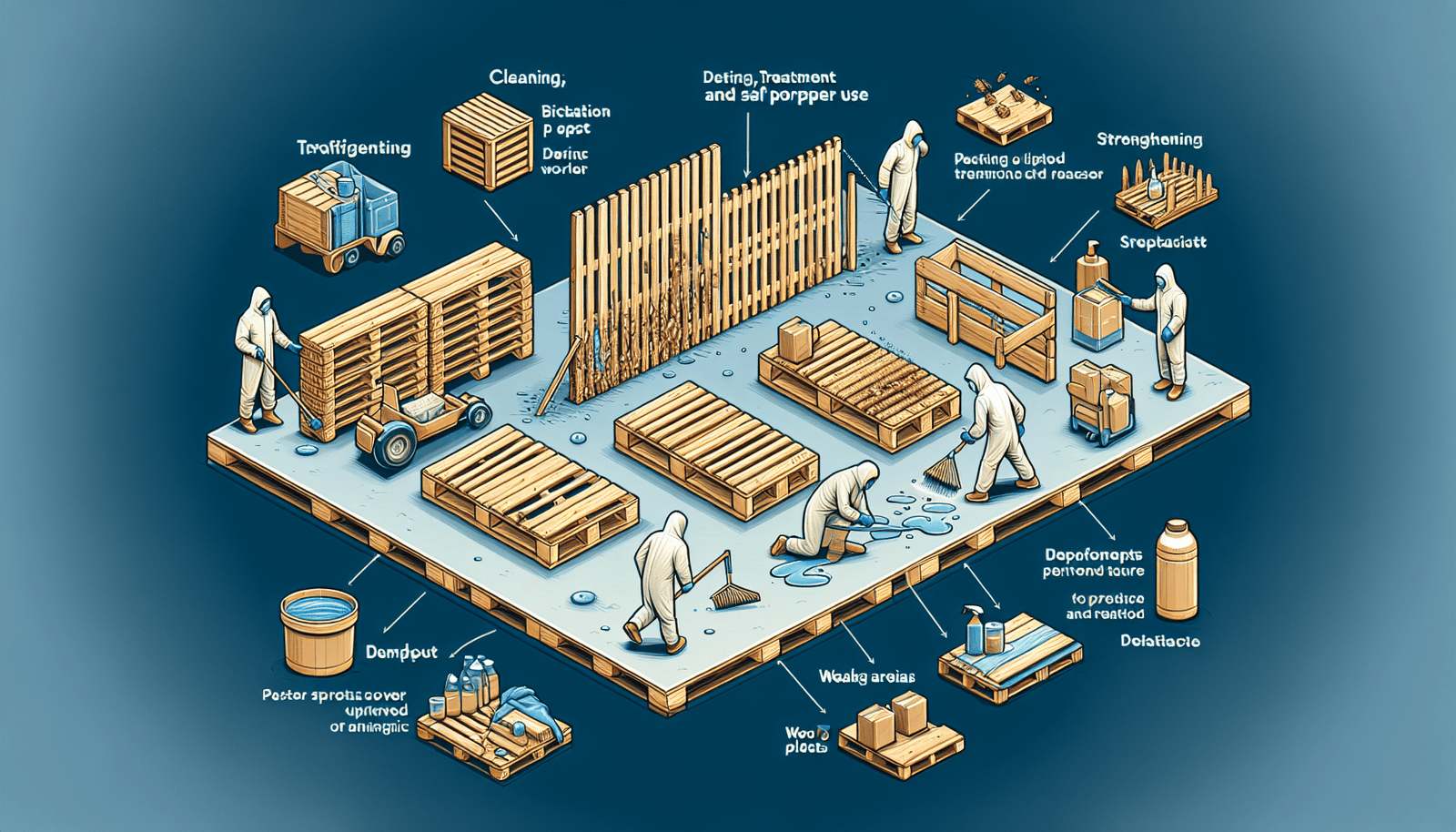If you’ve ever been curious about the steps involved in getting wood pallets ready for use, look no further. From assessing the condition of the pallets to treating and cleaning them, this article will walk you through the process, ensuring that you have all the necessary knowledge to prepare your wood pallets effectively. Whether you’re a DIY enthusiast, a business owner, or simply someone in need of pallets for a project, understanding the preparation steps is essential to ensure their longevity and usability. So, let’s get started, shall we?

Inspect the pallets for damage
Before you can start using wood pallets, it’s important to thoroughly inspect them for any signs of damage. This will ensure that the pallets are safe to use and will help prevent any accidents or injuries. One of the first things you should look for is broken or cracked boards. These can weaken the overall structure of the pallet and may cause it to collapse under weight. Additionally, check for any loose nails or screws that could pose a safety hazard. If you come across any damaged parts, it’s essential to address them before moving forward with the preparation process.
Clean the pallets
Once you have completed the inspection and ensured that the pallets are free from damage, the next step is to clean them thoroughly. Remember, the pallets may have been exposed to dirt, debris, or other substances during their previous use. To remove any unwanted materials, start by sweeping or brushing off any loose debris. This will help get rid of any dirt or dust that has accumulated on the pallets. For more stubborn dirt or grime, you can use a pressure washer or a scrub brush and soap to give the pallets a more thorough cleaning. This step will help create a clean and fresh surface for any future treatment or use.
Repair any damaged parts
If during the inspection you discovered any broken or cracked boards, it’s crucial to replace them before proceeding any further. Damaged boards can compromise the structural integrity of the pallet and make it unsafe to use. To repair the pallet, carefully remove the broken or cracked boards using the appropriate tools. Once the damaged boards are removed, replace them with new ones of the same size and thickness. Additionally, make sure to tighten any loose nails or screws that were identified during the inspection. This repair process will restore the pallet’s strength and ensure its long-lasting functionality.
Sand the pallets
To prepare the wood pallets for future use or treatment, it’s essential to sand the surfaces. This step helps to smooth out any rough areas and eliminates any potential splinters that could cause injury. Start by using a coarse grit sandpaper to remove any large imperfections on the surface of the pallets. Once the rough areas have been smoothed out, switch to a finer grit sandpaper to achieve a smoother finish. Remember to sand in the direction of the wood grain to effectively remove any roughness. By sanding the pallets, you are not only enhancing their appearance but also ensuring a safer and more comfortable handling experience.

Seal or stain the pallets
After the cleaning and repair process, it’s recommended to seal or stain the pallets to protect the wood from the elements, moisture, and general wear and tear. Applying a wood sealant or stain will help prolong the life of the pallets and maintain their aesthetic appeal. Prior to applying any sealant or stain, make sure the pallets are completely dry and free from any dust or debris. Choose a sealant or stain that is suitable for outdoor use if the pallets will be exposed to the elements. Apply the sealant or stain evenly to the entire surface of the pallets, using a brush or roller. Allow sufficient drying time before moving on to the next step.
Allow the pallets to dry
Once the sealant or stain has been applied, it’s crucial to allow the pallets to dry thoroughly before using or storing them. The drying time can vary depending on factors such as weather conditions and the specific type of sealant or stain used. It’s important to leave the pallets in a well-ventilated area where air can circulate around them. This will aid in the drying process and prevent any moisture from being trapped within the wood. Patience is key during this step, as rushing the drying process may compromise the effectiveness of the sealant or stain. To ensure that the pallets are fully dry, test the surface by lightly touching it with your finger. If there are no signs of stickiness or dampness, the pallets are ready for the next stage.
Apply a protective finish
To further enhance the durability and longevity of the pallets, it can be beneficial to apply a protective finish, such as varnish or polyurethane. While the sealant or stain provides initial protection, a protective finish acts as an additional barrier against moisture, scratches, and general wear. Before applying the finish, make sure the pallets are clean and dry. Use a brush or roller to apply an even coat of the protective finish to all exposed surfaces of the pallets. Allow the finish to dry according to the manufacturer’s instructions before using or storing the pallets. This extra step will not only extend the lifespan of the pallets but also enhance their overall appearance.
Use pallet accessories
To make the most out of your prepared wood pallets, consider adding various accessories to increase their functionality. One popular option is to attach caster wheels to the bottom corners of the pallets. These wheels will make it easier to move the pallets around, especially when loaded with heavy items. Another useful accessory is the addition of handles. Attaching handles to the sides of the pallets provides a convenient grip for lifting and carrying. Additionally, you may want to consider using pallet collars or dividers for improved organization. These accessories help create compartments within the pallets, making it simpler to categorize and transport smaller items.
Consider pallet treatment
If you want to further enhance the durability and resistance of the wood pallets, you can explore different treatment methods. One option is heat treatment, which involves exposing the pallets to high temperatures to eliminate any potential pests and insects that may be hiding within the wood. Another treatment method is chemical treatments, which involve applying specific solutions to the pallets to protect against rot, mold, and other damage caused by environmental factors. It’s important to note that these treatments should be conducted by professionals who have the knowledge and expertise to ensure the safety and efficacy of the process.
Use safety precautions
Lastly, it’s vital to prioritize safety when working with wood pallets. As you inspect, clean, repair, and treat the pallets, always wear protective gloves and eyewear. This will shield your hands and eyes from any potential splinters, debris, or chemical exposure. Additionally, make sure to follow proper lifting techniques when moving or handling the pallets to avoid strain or injury. Lift with your legs, not your back, and use team lift methods for heavier pallets. By taking these safety precautions, you can enjoy the process of preparing wood pallets for use while minimizing any potential risks or accidents.
In conclusion, preparing wood pallets for use involves a series of essential steps that ensure their safety, functionality, durability, and longevity. By inspecting for damage, cleaning, repairing, sanding, sealing or staining, allowing drying time, applying a protective finish, using accessories, considering treatment options, and prioritizing safety, you can transform simple pallets into versatile and reliable tools for various purposes. Whether you’re planning to use them for storage, transportation, or creative DIY projects, taking the time to prepare wood pallets properly will maximize their potential and contribute to a successful outcome. So roll up your sleeves, gather your supplies, and get ready to unlock the full potential of your wood pallets!

Hi, I’m James Gheen, the creator behindWoodRebirth.com. As someone passionate about sustainability and environmental stewardship, I created this pioneering online platform to change how we approach wood waste and pallet disposal. Through detailed recycling and disposal guides, creative DIY projects, and upcycling inspirations, I aim to inspire individuals and businesses to adopt eco-friendly practices in their wood waste management. At WoodRebirth.com, we foster a vibrant community focused on education and engagement, encouraging the sharing of ideas and success stories. Join me in our mission to give wood waste a new lease on life, making a tangible impact on our environment, one pallet at a time.

